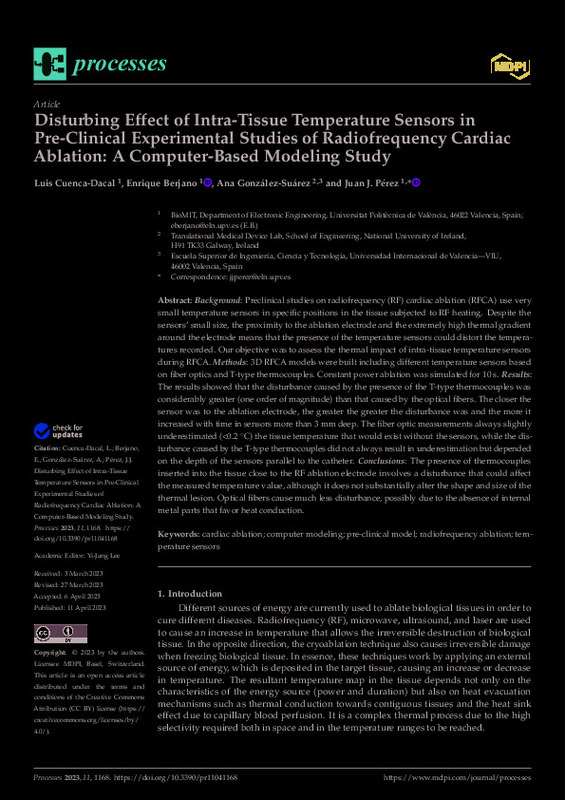JavaScript is disabled for your browser. Some features of this site may not work without it.
Buscar en RiuNet
Listar
Mi cuenta
Estadísticas
Ayuda RiuNet
Admin. UPV
Disturbing Effect of Intra-Tissue Temperature Sensors in Pre-Clinical Experimental Studies of Radiofrequency Cardiac Ablation: A Computer-Based Modeling Study
Mostrar el registro sencillo del ítem
Ficheros en el ítem
| dc.contributor.author | Cuenca-Dacal, Luis
|
es_ES |
| dc.contributor.author | Berjano, Enrique
|
es_ES |
| dc.contributor.author | González-Suárez, Ana
|
es_ES |
| dc.contributor.author | Pérez, Juan J
|
es_ES |
| dc.date.accessioned | 2023-05-12T18:01:58Z | |
| dc.date.available | 2023-05-12T18:01:58Z | |
| dc.date.issued | 2023-04-11 | es_ES |
| dc.identifier.uri | http://hdl.handle.net/10251/193321 | |
| dc.description.abstract | [EN] Background: Preclinical studies on radiofrequency (RF) cardiac ablation (RFCA) use very small temperature sensors in specific positions in the tissue subjected to RF heating. Despite the sensors' small size, the proximity to the ablation electrode and the extremely high thermal gradient around the electrode means that the presence of the temperature sensors could distort the temperatures recorded. Our objective was to assess the thermal impact of intra-tissue temperature sensors during RFCA. Methods: 3D RFCA models were built including different temperature sensors based on fiber optics and T-type thermocouples. Constant power ablation was simulated for 10 s. Results: The results showed that the disturbance caused by the presence of the T-type thermocouples was considerably greater (one order of magnitude) than that caused by the optical fibers. The closer the sensor was to the ablation electrode, the greater the greater the disturbance was and the more it increased with time in sensors more than 3 mm deep. The fiber optic measurements always slightly underestimated (<0.2 'C) the tissue temperature that would exist without the sensors, while the disturbance caused by the T-type thermocouples did not always result in underestimation but depended on the depth of the sensors parallel to the catheter. Conclusions: The presence of thermocouples inserted into the tissue close to the RF ablation electrode involves a disturbance that could affect the measured temperature value, although it does not substantially alter the shape and size of the thermal lesion. Optical fibers cause much less disturbance, possibly due to the absence of internal metal parts that favor heat conduction. | es_ES |
| dc.description.sponsorship | This research was funded by the Spanish Ministerio de Ciencia e Innovación/Agencia Estatal de Investigación (MCIN/AEI/10.13039/501100011033) by Grant number PID2022-136273OBC31 and PID2022-136273OA-C33. | es_ES |
| dc.language | Inglés | es_ES |
| dc.publisher | MDPI AG | es_ES |
| dc.relation.ispartof | Processes | es_ES |
| dc.rights | Reconocimiento (by) | es_ES |
| dc.subject | Cardiac ablation | es_ES |
| dc.subject | Computer modeling | es_ES |
| dc.subject | Pre-clinical model | es_ES |
| dc.subject | Radiofrequency ablation | es_ES |
| dc.subject | Temperature sensors | es_ES |
| dc.subject.classification | TECNOLOGIA ELECTRONICA | es_ES |
| dc.title | Disturbing Effect of Intra-Tissue Temperature Sensors in Pre-Clinical Experimental Studies of Radiofrequency Cardiac Ablation: A Computer-Based Modeling Study | es_ES |
| dc.type | Artículo | es_ES |
| dc.identifier.doi | 10.3390/pr11041168 | es_ES |
| dc.relation.projectID | info:eu-repo/grantAgreement/AEI//PID2022-136273OBC31/ | es_ES |
| dc.relation.projectID | info:eu-repo/grantAgreement/AEI//PID2022-136273OA-C33/ | es_ES |
| dc.rights.accessRights | Abierto | es_ES |
| dc.contributor.affiliation | Universitat Politècnica de València. Escuela Técnica Superior de Ingenieros Industriales - Escola Tècnica Superior d'Enginyers Industrials | es_ES |
| dc.contributor.affiliation | Universitat Politècnica de València. Escuela Técnica Superior de Ingeniería del Diseño - Escola Tècnica Superior d'Enginyeria del Disseny | es_ES |
| dc.description.bibliographicCitation | Cuenca-Dacal, L.; Berjano, E.; González-Suárez, A.; Pérez, JJ. (2023). Disturbing Effect of Intra-Tissue Temperature Sensors in Pre-Clinical Experimental Studies of Radiofrequency Cardiac Ablation: A Computer-Based Modeling Study. Processes. 11(4):1-13. https://doi.org/10.3390/pr11041168 | es_ES |
| dc.description.accrualMethod | S | es_ES |
| dc.relation.publisherversion | https://doi.org/10.3390/pr11041168 | es_ES |
| dc.description.upvformatpinicio | 1 | es_ES |
| dc.description.upvformatpfin | 13 | es_ES |
| dc.type.version | info:eu-repo/semantics/publishedVersion | es_ES |
| dc.description.volume | 11 | es_ES |
| dc.description.issue | 4 | es_ES |
| dc.identifier.eissn | 2227-9717 | es_ES |
| dc.relation.pasarela | S\487281 | es_ES |
| dc.contributor.funder | Agencia Estatal de Investigación | es_ES |








